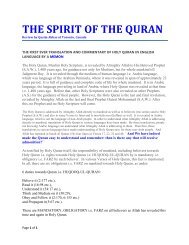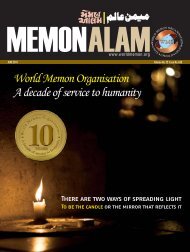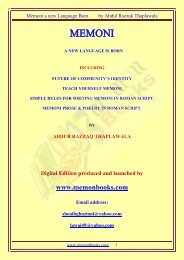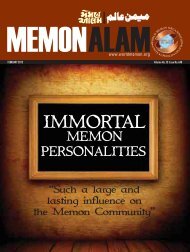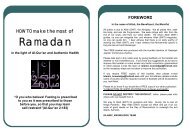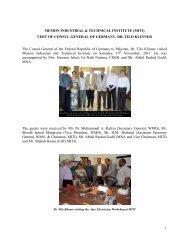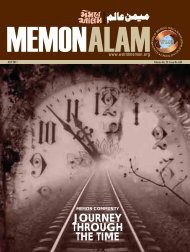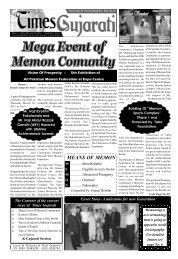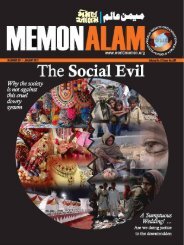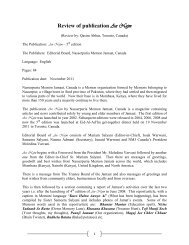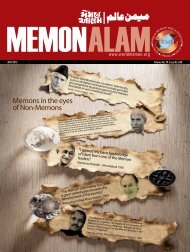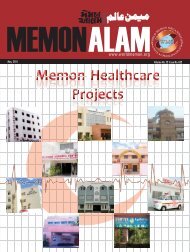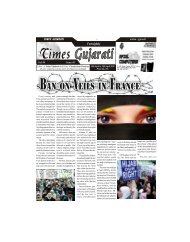Memoirs of Abdul Razzak Thaplawala - Memon Books
Memoirs of Abdul Razzak Thaplawala - Memon Books
Memoirs of Abdul Razzak Thaplawala - Memon Books
Create successful ePaper yourself
Turn your PDF publications into a flip-book with our unique Google optimized e-Paper software.
<strong>Memoirs</strong> <strong>of</strong> <strong>Abdul</strong> <strong>Razzak</strong> <strong>Thaplawala</strong><br />
<strong>Memoirs</strong> <strong>of</strong> <strong>Abdul</strong> <strong>Razzak</strong> <strong>Thaplawala</strong><br />
Digital Edition<br />
By <strong>Abdul</strong> <strong>Razzak</strong> <strong>Thaplawala</strong><br />
Digital Edition produced and launched by<br />
www.memonbooks.com<br />
Email address:<br />
shoaibghaziani@yahoo.com<br />
lawai49@yahoo.com<br />
www.memonbooks.com 1
<strong>Memoirs</strong> <strong>of</strong> <strong>Abdul</strong> <strong>Razzak</strong> <strong>Thaplawala</strong><br />
www.memonbooks.com 2
<strong>Memoirs</strong> <strong>of</strong> <strong>Abdul</strong> <strong>Razzak</strong> <strong>Thaplawala</strong><br />
All rights reserves to the Author<br />
Name <strong>of</strong> Book:<br />
Auther:<br />
<strong>Memoirs</strong> <strong>of</strong> A.<strong>Razzak</strong> <strong>Thaplawala</strong><br />
<strong>Abdul</strong> <strong>Razzak</strong> <strong>Thaplawala</strong><br />
Digital Edition APRIL 2011<br />
Digitalized by Qasim Moosa Lawai (www.memonbooks.com)<br />
Technical Advisor: Shoaib Ghaziani (www.memonbooks.com)<br />
Print Edition: 2008<br />
No. <strong>of</strong> Copies: 1000<br />
ISBN No: 978-969-8935-02-3<br />
Price:<br />
Website:<br />
Free<br />
www.memonbooks.com<br />
Any part or whole <strong>of</strong> the contents <strong>of</strong> this book can be freely<br />
printed without permission <strong>of</strong> the author but without any alteration.<br />
The source may please be acknowledged. It will be appreciated if a<br />
copy <strong>of</strong> the publication in which any part <strong>of</strong> this booklet are<br />
reproduced is sent to the author<br />
Compiled & Published by<br />
Abdur Razzaq <strong>Thaplawala</strong><br />
Phone: 111-786-555 Fax: 4534302<br />
E-mail: arthaplawala@yahoo.com<br />
www.memonbooks.com 3
<strong>Memoirs</strong> <strong>of</strong> <strong>Abdul</strong> <strong>Razzak</strong> <strong>Thaplawala</strong><br />
All rights reserves to the Author<br />
Publications by the same auther Mr. Abdur Razzaq <strong>Thaplawala</strong><br />
Illegal Occupation <strong>of</strong> Junagadh - A Pakistani Territory ISBN # 978-969-8935-02-3<br />
Bantva Kul Aur Aaj ISBN # 978-969-8935-01-6<br />
<strong>Memon</strong>i – A New Language is Born ISBN # 969-8606-01-7<br />
<strong>Memon</strong> Community & Future <strong>of</strong> its identity ISBN # 969-8606-00-9<br />
<strong>Memon</strong> Community – A Brief Historical Perspective ISBN # 969-8634-00-9<br />
The <strong>Memon</strong> Community – ISBN # 969-8935-00-2<br />
Its’ origin, history, culture, tradition & language<br />
Any part or whole <strong>of</strong> the contents <strong>of</strong> this book can be freely<br />
printed without permission <strong>of</strong> the author but without any alteration.<br />
The source may please be acknowledged. It will be appreciated if a<br />
copy <strong>of</strong> the publication in which any part <strong>of</strong> this booklet are<br />
reproduced is sent to the author.<br />
Compiled and Published by<br />
Abdur Razzaq <strong>Thaplawala</strong><br />
C-15, Dawood Cooperative Housing Society, Karachi-74800<br />
Phone: Off: 4534235 Fax: 4534302 Res: 4930229 Mobile: 0300-8223787<br />
e-mail: arthaplawala@lucky-cement.com<br />
www.memonbooks.com 4
<strong>Memoirs</strong> <strong>of</strong> <strong>Abdul</strong> <strong>Razzak</strong> <strong>Thaplawala</strong><br />
<strong>Memoirs</strong> <strong>of</strong> <strong>Abdul</strong> <strong>Razzak</strong> <strong>Thaplawala</strong><br />
BY ABDUR RAZZAQ THAPLAWALA<br />
Table <strong>of</strong> Contents<br />
BIRTH PLACE REVISITED .................................................................. 6<br />
BOMBAY .............................................................................................. 7<br />
RAJKOT ............................................................................................... 7<br />
JUNAGADH ......................................................................................... 9<br />
VANTHALI .......................................................................................... 10<br />
BANTVA ............................................................................................. 12<br />
BANTVA RAILWAY STATION ........................................................... 13<br />
THAPLA & KODVAV ......................................................................... 14<br />
DHORAJI ............................................................................................ 15<br />
MY MEMORIES OF BANTVA ............................................................ 17<br />
LAST DAYS OF JUNAGADH ............................................................ 22<br />
ABOUT THE AUTHOR ....................................................................... 25<br />
www.memonbooks.com 5
<strong>Memoirs</strong> <strong>of</strong> <strong>Abdul</strong> <strong>Razzak</strong> <strong>Thaplawala</strong><br />
BIRTH PLACE REVISITED<br />
BY: ABDUR RAZZAQ THAPLAWALA<br />
I had migrated from Bantva in the 3 rd week <strong>of</strong> November, 1947<br />
after the houses <strong>of</strong> Muslims were attacked by Hindu farmers on 15 th<br />
November, 1947. The houses were attacked inspite <strong>of</strong> the fact that there<br />
was night curfew and Sikh soldiers were on duty at each Street and<br />
Mohalla. At that time, I was 11 years old but I still remember the sounds<br />
<strong>of</strong> save us or (Bachao, Bachao) from the women folks whose houses<br />
were being attacked.<br />
On 16 th November, 1947, when the curfew was relaxed for a few<br />
hours, all the residence <strong>of</strong> Bantva gathered at the Bazar outside the<br />
main gate (Zapa) <strong>of</strong> Bantva. cas well. Although, there was no bloodshad<br />
in Bantva but the houses were attacked in the presence <strong>of</strong> Sikh solders.<br />
The residents <strong>of</strong> Bantva were fearful and decided to leave for Pakistan as<br />
soon as possible. Because <strong>of</strong> this decision, the 25,000 Muslim<br />
populations’ majority <strong>of</strong> whom were <strong>Memon</strong>s decided to migrate to<br />
Pakistan. Within 3 days, the residents <strong>of</strong> Bantva started leaving for<br />
Bombay or Okha from where they migrated to Pakistan by steamships.<br />
After migration in the 3 rd week <strong>of</strong> November, 1947, I did not have<br />
the opportunity <strong>of</strong> visiting Bantva and its surrounding cities until 21 st<br />
March, 2005.<br />
I was invited to participate in a seminar on cement industry being<br />
held in the first week <strong>of</strong> January, 2005 at Mumbai. I was also invited by<br />
some cement machinery manufacturers to have a look at machinery<br />
manufactured in India. I decided that I should visit Mumbai and<br />
surrounding places but at the same time I should take this opportunity<br />
www.memonbooks.com 6
<strong>Memoirs</strong> <strong>of</strong> <strong>Abdul</strong> <strong>Razzak</strong> <strong>Thaplawala</strong><br />
<strong>of</strong> visiting my birth place. I therefore applied for visa to Indian High<br />
Commission with including visa for Rajkog, Junagadh and Bantva.<br />
Unfortunately, Indian High Commission lost my passport and inspite <strong>of</strong><br />
several efforts, the passport could not be found. I had to obtain a new<br />
passport.<br />
BOMBAY<br />
The World <strong>Memon</strong> Organization (WMO) had organized its 5 th<br />
Annual General Meeting at Mumbai from 25 th to 28 th March, 2005. I<br />
decided to take this opportunity to visit my birth place. Many persons<br />
who were attending the conference <strong>of</strong> World <strong>Memon</strong> Organization (WMO)<br />
had applied for visa to visit Bantva but no visa was granted to them. As I<br />
had applied for visa to Rajkot, Junagadh and Bantva in December, 2004,<br />
I was granted the visa <strong>of</strong> Rajkot, Junagadh and Bantva in addition to<br />
Mumbai.I therefore, decided to leave for India on 21 st March, 2005 – a<br />
few days earlier for Mumbai Conference. In Mumbai, I had requested a<br />
very senior elder <strong>of</strong> our community – Bha Adam Noor to kindly arrange<br />
for my visit to Junagadh & Bantva. I left Karachi by PIA Flight No. 274 at<br />
9:00 A.M. and reached Mumbai Airport at 11:00 A.M. (India time). My<br />
friend had sent a person to receive me at the Airport. I took a taxi to the<br />
<strong>of</strong>fice <strong>of</strong> The <strong>Memon</strong> Educational & Welfare Society. As requested earlier,<br />
they had booked a flight living for Rajkot at 7:00 P.M. that very evening.<br />
RAJKOT<br />
I left my luggage in the <strong>of</strong>fice <strong>of</strong> The <strong>Memon</strong> Educational &<br />
Welfare Society and took a small trolly bag with me which contained<br />
clothing for 3 days. The Jet Airways flight took me from Mumbai to to<br />
Rajkot. The flight time was 45 minutes and the return fair was Rs.<br />
7,800/=. At Rajkot Airport, I was received by a friend Mr. Farooq who<br />
was requested by Mr. Adam Noor to receive me. Mr. Farooq was there at<br />
the airport to receive me. He had booked a room in Hotel Kavery,<br />
Rajkot. It took me one hour to reach my Hotel. We had arranged a<br />
www.memonbooks.com 7
<strong>Memoirs</strong> <strong>of</strong> <strong>Abdul</strong> <strong>Razzak</strong> <strong>Thaplawala</strong><br />
Suzuki Hiro<strong>of</strong> for our tour. Before living Rajkot next morning, I was<br />
shown the Adamjee Boarding House at Rajkot. The plaque at the<br />
Adamjee Boarding House read following in Gujrati:<br />
“Sir Adamjee Haji Dawood constructed this Boarding House at a<br />
cost <strong>of</strong> Rs. 14,050 on the occasion <strong>of</strong> the wedding ceremony <strong>of</strong> his son.<br />
The foundation stone was laid on 2 nd February, 1941 by the State<br />
Resident Major G.B. Williams. The Boarding House was completed and<br />
declared open on 19 th Janaury, 1942 by Janab Haji <strong>Abdul</strong> Shakoor Baig<br />
Muhammad Subasha.”<br />
The Boarding House is a beautiful building constructed on a plot<br />
measuring 12,500 sq.yards. When I visited the Boarding House, the<br />
building was in good shape but it was rented out to a Government<br />
department and two private firms. There were 15 boarders who were<br />
living in kitchen and dining room <strong>of</strong> the Boarding House. Out <strong>of</strong> these 15<br />
students only 5 students were from <strong>Memon</strong> community. The Boarding<br />
House is located at the prime locality <strong>of</strong> Rajkot. Unfortunately, the<br />
<strong>Memon</strong> community <strong>of</strong> Rajkot does not appear to have taken care <strong>of</strong> the<br />
Boarding House and thus the wishes <strong>of</strong> Sir Adamjee Haji Dawood to<br />
accommodate <strong>Memon</strong> students did not materialize. This was a very sorry<br />
state <strong>of</strong> affairs. I explained this state <strong>of</strong> affairs to the community elders<br />
at one <strong>of</strong> the meeting <strong>of</strong> Board <strong>of</strong> Management <strong>of</strong> World <strong>Memon</strong><br />
Organization held at Mumbai on 27 th March, 2005. I was told by some<br />
Indian dignitories that they are trying to revive the Boarding House.<br />
According to a conservative estimate, the present value <strong>of</strong> land and<br />
building <strong>of</strong> Boarding House is about Rs. 25 crores.<br />
Rajkot has a population <strong>of</strong> about 1.1 Million people out <strong>of</strong> which<br />
100,000 people belong to Muslim community and there are about 5,000<br />
persons who belong to <strong>Memon</strong> community.<br />
www.memonbooks.com 8
<strong>Memoirs</strong> <strong>of</strong> <strong>Abdul</strong> <strong>Razzak</strong> <strong>Thaplawala</strong><br />
JUNAGADH<br />
After visiting the Boarding House, I left Rajkot for Junagadh. It<br />
took me 2 hours to reach Junagadh because it was a very good<br />
Highway. During our journey from Rajkot to Junagadh, we also passed<br />
through the city <strong>of</strong> Jetpur. It looked like a well populated and prosperous<br />
city. Unfortunately, I could not go and see any place <strong>of</strong> interest in Jetpur<br />
as I did not know anything about it. I reached Junagadh at about 2:00<br />
P.M. After taking a room in a hotel and finishing our lunch, I decided to<br />
spend the afternoon for sight seeing <strong>of</strong> Junagadh. First <strong>of</strong> all, I went to<br />
see Nawab Mahabbat Khanjee College. The College has separate<br />
buildings for Arts and Science. It is still known as Sir Mahabbat Khanjee<br />
College.<br />
After visiting the College, I visited the Makbara <strong>of</strong> Sir Mahabbat<br />
Khanjee. It is a huge, beautiful, and artistic historical structure. Besides<br />
the Makbara, there is a big & beautiful Mosque. I do not know how many<br />
Muslims <strong>of</strong>fer prayer in this Mosque. After visiting the Makbara <strong>of</strong> Sir<br />
Mahabbat Khangee, I took round <strong>of</strong> Junagadh & saw many new gates<br />
built on the roads.<br />
Then I proceeded to see the Girnar Mountain and Data Darbar. The<br />
main Mazar <strong>of</strong> Data Darbar is situated on a mountain and it was difficult<br />
for me to climb such a height. At the bottom <strong>of</strong> the steps <strong>of</strong> Data Darbar,<br />
therer is a Chilla <strong>of</strong> Data Darbat. This Chilla or Dargah is a beautiful<br />
place. I photographed it. I also photographed the stairs leading to the<br />
Data Darbar on the mountain. I remember that in my childhood, I had<br />
climbed the stairs and seen the Mazaar <strong>of</strong> Data Darbat up on the hill.<br />
This was not possible this time because <strong>of</strong> my age factor. While<br />
returning from Data Darbar, we saw a small Dargah or what we call<br />
Chilla <strong>of</strong> Peer Geban Shah.<br />
After returning from Data Darbar, I was told to visit the <strong>Memon</strong><br />
Colony built by World <strong>Memon</strong> Foundation in Baker Falia. This colony had<br />
4 Apartment Buildings and was built by World <strong>Memon</strong> Foundation in<br />
Association with Dhoraji Association. The condition <strong>of</strong> the colony was<br />
www.memonbooks.com 9
<strong>Memoirs</strong> <strong>of</strong> <strong>Abdul</strong> <strong>Razzak</strong> <strong>Thaplawala</strong><br />
pathetic. The water & sewerage lines were not functioning and the entire<br />
compound <strong>of</strong> the colony was dug up for improving water & sewerage<br />
lines. The residents <strong>of</strong> colony were very poor and complaining that no<br />
steps had been taken by the builders <strong>of</strong> the colony to do the necessary<br />
repairing work. Some <strong>of</strong> the ladies <strong>of</strong> the colony told me to see their<br />
rooms and observe the sub-human filthy conditions in which they were<br />
living. Two persons supervising the sewerage work told me that no<br />
resident <strong>of</strong> colony was prepared to share the expenses except those<br />
living on ground floor who were most affected. I hope that the World<br />
<strong>Memon</strong> Foundation and Dhoraji Association will take steps to come to<br />
the rescue <strong>of</strong> poor residents <strong>of</strong> this colony which was in Baker Falia.<br />
Junagadh has a population <strong>of</strong> 700,000 people out <strong>of</strong> which<br />
100,000 people are Muslims. The population <strong>of</strong> <strong>Memon</strong> community in<br />
Junagadh is about 11,000.<br />
VANTHALI<br />
I spent the night in Hotel Paramount <strong>of</strong> Junagadh. Next morning,<br />
we started for visit to Bantva - my birthplace. The road leading to<br />
Bantva was good and passed through Vanthali. There were farms on<br />
both the sides <strong>of</strong> the road. Within an hour, we reached Vanthali, our first<br />
stop in the journey to Bantva. On he main road <strong>of</strong> Vanthali, there is a<br />
JamiaTaaleem-ul-Quran, which is run by Jamia Taaleemul-Quran<br />
Charitable Trust, Vanthali. The Jamia was established in September<br />
1996. Almost all the trustees are non-<strong>Memon</strong>s but funds were coming<br />
from the <strong>Memon</strong> philanthropists from all over the Gujrat. It has a<br />
magnificent & beautiful building. More than 1000 students are studying<br />
at this Jamia and the Jamia is spending Rs. 42 lacs per year. The<br />
students are tought Arabic, Farsi, Hifz Quran, Nazira Quran and<br />
computer science. They have a very well stocked library, Masjid and<br />
residential quarters. I visited a classroom where lessons in Hadees were<br />
being taught to the students. I also visited their computer room, which<br />
contained 10 modern computers. The following are the statistics <strong>of</strong> the<br />
students studying at the Jamia.<br />
www.memonbooks.com 10
<strong>Memoirs</strong> <strong>of</strong> <strong>Abdul</strong> <strong>Razzak</strong> <strong>Thaplawala</strong><br />
1. Aalim 21<br />
2. Qaari 41<br />
3. Hifz 35<br />
4. Naazra 426<br />
5. Computer studies 21<br />
6. Tailoring 19<br />
7. Education upto 7 th standard 168<br />
The Jamia is also running Markatib or schools at the following<br />
places other than the main Jamia in Vanthali:<br />
1. Vanthali 350 students<br />
2. Nawalakhi 150 students<br />
3. Lilwa 100 students<br />
4. Sattalpur 50 students<br />
5. Koab 100 students<br />
A <strong>Memon</strong> colony is situated very near the Jamia. I went to the<br />
<strong>Memon</strong> Colony. The colony has been built by World <strong>Memon</strong> Foundation<br />
with the help <strong>of</strong> Vanthali <strong>Memon</strong> Jamat. The buildings in the <strong>Memon</strong><br />
colony were apparently in good condition but the ladies at the colony<br />
complained that they have the houses but their manfolk have no jobs.<br />
They were doing different labour work and hardly earning enough to<br />
meet both ends. They requested that the community elders should do<br />
something to provide some sort <strong>of</strong> jobs for their manfolk.<br />
The population <strong>of</strong> Vanthali is about 20,000 people. This includes<br />
4,000 Muslims and about 1,500 people belong into <strong>Memon</strong> community.<br />
After Vanthali, we proceed to Manavadar, which was only 22 KM<br />
from Vanthali. I did not see any place <strong>of</strong> interest at Manavadar. The<br />
distance between Bantva and Manavadar is only 8 KM.<br />
www.memonbooks.com 11
<strong>Memoirs</strong> <strong>of</strong> <strong>Abdul</strong> <strong>Razzak</strong> <strong>Thaplawala</strong><br />
BANTVA<br />
From Manavadar, we proceeded to Bantva “my birth place”. To<br />
begin with I went to the <strong>of</strong>fice <strong>of</strong> Bantva Municipality which is known as<br />
Bantva Municipal Bureau. The <strong>of</strong>fices <strong>of</strong> Municipality are located on the<br />
first floor <strong>of</strong> building which we know as Mohammadan Library <strong>of</strong> our old<br />
days. I met the <strong>of</strong>ficers <strong>of</strong> the Municipality and told them that I had<br />
come to see my birth place. They were very kind and sent one <strong>of</strong> their<br />
man with me to take me around the Bantva. To begin with we went to<br />
what was known as main gate or Zapa <strong>of</strong> Bantva. The Zapa was no<br />
longer there. We went in the bazaar inside the Zapa till the Jamia<br />
Masjid. It’s a very beautiful Masjid and the inside and outside condition<br />
was still very good inspite <strong>of</strong> passage <strong>of</strong> time. My house was behind the<br />
Jamia Masjid in Jangra falia. The way to Jangra falia started with<br />
residence, <strong>of</strong>fices and motor garages <strong>of</strong> Adam Haji Peermuhammad<br />
(Adam Limited). Unfortunately, all the buildings in this area including<br />
Adam Limited’s <strong>of</strong>fices, residential houses and the motor garages had<br />
decayed with the passage <strong>of</strong> time or has been demolished and only a<br />
locked compound existed. I proceeded further to see the house where I<br />
leaved but could find none because all the houses in Jangra Falia, Agasi<br />
Falia & the passage to Rankot were demolished and nothing could be<br />
recognized.<br />
After visiting the Masjid, we went outside the so-called Zapa.<br />
There were shops and bazaar outside Zapa and I could see that all kinds<br />
<strong>of</strong> shopkeepers were doing roaring business. Here I met Mr. Nikom<br />
Advocate an old friend <strong>of</strong> brother Siddique Polani. I gave him the copy <strong>of</strong><br />
History <strong>of</strong> Banva which was given to me by Siddique Bha. Mr. Nikom<br />
Advocate was very happy to see us. He accompanied us to the tour <strong>of</strong><br />
Bantva. There was a Masjid known as Barwali Masjid outside the Zapa. It<br />
was locked and was in very bad condition. I also went to see the Mazaar<br />
<strong>of</strong> Bukhari Sharif. The Mazar is now situated in a beautiful garden and it<br />
is in good condition. Going back towards Mohammadan library, we saw<br />
Mosque built by Hussain Kasim Dada. It was in a very bad shap. Then<br />
we started for Madrassa-e-Islamia and Yateem Khana. The Yateem<br />
Khana has been converted into a Girls School and Madrassa now<br />
www.memonbooks.com 12
<strong>Memoirs</strong> <strong>of</strong> <strong>Abdul</strong> <strong>Razzak</strong> <strong>Thaplawala</strong><br />
contains a Boys School. The foundation stone <strong>of</strong> Yateem Khana Islamia<br />
Bantva read as follows:<br />
“The opening ceremony <strong>of</strong> this building was performed by Bantva<br />
Sardar Gadh Darbar Saheb Zabardast Khanjee on Tuesday 21 st Jamadiul<br />
Aakhir 1356 Hijri and 8 th August, 1939.”<br />
The Girls School and Boys School are being run by a Trust. The<br />
Trust is renovating some buildings and also constructing new blocks.<br />
The foundation stone <strong>of</strong> Madrassa-e-Islamia read as follows:<br />
“Madrassa-e-Islamia was opened by Left. Col. J.A. Oilfield Political<br />
Agent <strong>of</strong> Sorath Parant (Province) on 21 st December, 1930.”<br />
Both the schools are know known as Sunshine schools. On the way<br />
to Madrassa-e-Islamia, I noticed the buildings <strong>of</strong> Bantva, Gymkhana &<br />
Muslim Trust. I was told that <strong>Memon</strong>s from Dhoraji were taking care <strong>of</strong><br />
some Mosques & Dargahs in Bantva and no <strong>Memon</strong> from Bantva was<br />
giving help.<br />
BANTVA RAILWAY STATION<br />
After visiting the Yateem Khana and Madrassa-e-Islamia, I<br />
proceeded towards the old Railway Station. The outside building <strong>of</strong><br />
Railway Station looked good as I remembered it in my childhood. Inside<br />
the building, I also saw the Ticket Distribution window, which still has<br />
the instructions for passengers in Gujrati. On the other side <strong>of</strong> the<br />
building, however, there were no signs <strong>of</strong> a Railway Station. After seeing<br />
the Railway Station, I proceeded to see the hospital built by Haji Habib<br />
Culcuttawala. The hospital building was old but not in very bad<br />
condition. Now it houses a library. Along side the hospital building, there<br />
was a mosque. I visited the mosque built by Haji Habib Culcuttawala. It<br />
was in a pathetic condition. All the Mehrabs and the mimber had<br />
decayed or demolished. A Muslim family was living inside it. They<br />
www.memonbooks.com 13
<strong>Memoirs</strong> <strong>of</strong> <strong>Abdul</strong> <strong>Razzak</strong> <strong>Thaplawala</strong><br />
requested us to enter the mosque premises after taking <strong>of</strong>f shoes. We<br />
did that but I was very much disturbed by seeing the condition <strong>of</strong> the<br />
Mosque. No mimber, no mehrabs but the lining for safbandi for Namaz<br />
could be seen.<br />
The Kohinoor talkies, the only cinema house in Bantva was<br />
opposite the hospital. It was closed. I was told that it functioned for a<br />
few years as Jay Hind Cinema.<br />
Then I proceeded to Bantva <strong>Memon</strong> Jamat Khana. A portion <strong>of</strong><br />
Jamat Khana was functioning as Sindhi student’s school. I could see the<br />
classrooms & desks where I studied upto 2 nd class before joining<br />
Madrassa-e-Islamia. The Class Rooms <strong>of</strong> the school were apparently in<br />
good condition and I could see school desks in most <strong>of</strong> the rooms.<br />
Then I started for going out <strong>of</strong> Banva and saw Ahmed Dawoods<br />
Gening Factory, which is now running as Oil Mills on Pajot Road. Our<br />
friend took us to the house <strong>of</strong> the Late Danilal Kalilal who worked as<br />
Manager <strong>of</strong> Haji Habib Calcuttawala. He died on 10 th April, 2001. His son<br />
Kanti Bhai invited us to his house and served tea to us. Mr. Kanti Laal is<br />
also a retired person and had good collection <strong>of</strong> books.<br />
Bantva is said to have population <strong>of</strong> 18,000 people. There are only<br />
150 Muslims and 3 or 4 <strong>Memon</strong> families in Bantva.<br />
The Bantva, Thapla and Kodvav are part <strong>of</strong> the, what is known as<br />
Manawadar Taluka District: Junagadh.<br />
THAPLA & KODVAV<br />
My surname is THAPLAWALA but my parents or elders had not told<br />
me the meaning <strong>of</strong> this surname. After coming to Pakistan, I looked at<br />
the maps <strong>of</strong> Gujrat and saw that Bantva was surrounded by many small<br />
villages and many families had their surname linked with these villages<br />
including Balagam, Kodvav, Pajod etc. These villages included a village<br />
www.memonbooks.com 14
<strong>Memoirs</strong> <strong>of</strong> <strong>Abdul</strong> <strong>Razzak</strong> <strong>Thaplawala</strong><br />
named THAPLA. I had a keen desire to visit & see THAPLA. We left<br />
Bantva and started our journey towards these villages. On our way to<br />
THAPLA, we passed through Aiklaria and then the Kodvav. I was told<br />
that the population <strong>of</strong> Kodvav was 1500 persons belonging to Patel<br />
community. After seeing Kodvav, We proceeded towards THAPLA. It is a<br />
small town with a population <strong>of</strong> 600 people. At the outside <strong>of</strong> THAPLA,<br />
there was a Mazaar or Chilla <strong>of</strong> Peer Geban Shah. It was being looked<br />
after by a Muslim couple Mr. & Mrs. Fakeer Allah Rakha Qasim. Both the<br />
THAPLA & KODVAV have small schools. The school in THAPLA is known<br />
as Study Centre and the school in KODVAV is known as school. I have<br />
photographed both schools <strong>of</strong> THAPLA & KODVAV which may appear in<br />
this article.<br />
After seeing THAPLA, we decided to start our return journey. We<br />
decided that instead <strong>of</strong> going back to Junagadh, we should dreictly<br />
proceed to Rajkot through Sardargadh & Dhoraji.<br />
DHORAJI<br />
Before reaching Dhoraji, we went through Upleta by pass. We<br />
started for Rajkot at 2;30 P.M through Sardargadh. We reached<br />
Sardargadh at 3:00 P.M. and proceeded towards Dhoraji. Dhoraji is a<br />
sprawling city. We went to see the Mazaar <strong>of</strong> Peer Sailani and the<br />
Mosque near it.. In Dhoraji, we went to Dhoraji branch <strong>of</strong> <strong>Memon</strong><br />
cooperative Bank Limited and met its Manger Mr. Aqeel R. Patel. He said<br />
that the bank had deposits <strong>of</strong> Rs. 10 crore on 31 st March, 2004. The total<br />
loans amounted to Rs. 3 crore at the year ended on 31 st March, 2004<br />
and bank made pr<strong>of</strong>it <strong>of</strong> Rs. 25 lacs during that year. Mr. Imran A.<br />
Furniturewala is Chairman AND Mr. A. Majid Patka is the Vice Chairman<br />
<strong>of</strong> the Bank. The Bank has 70 branches all over Gujrat and in Mumbai.<br />
Late Janab Al-Haaj Zakaria Aghari established the Bank.<br />
After Dhoraji, we proceeded towards Rajkot. We reached Rajkot in<br />
evening time on 23 rd March, 2005. I had a booking to leave Rajkot by<br />
evening flight next day on 24 th March, 2005. Since I was very much tired<br />
www.memonbooks.com 15
<strong>Memoirs</strong> <strong>of</strong> <strong>Abdul</strong> <strong>Razzak</strong> <strong>Thaplawala</strong><br />
and nothing to do at Rajkot, I decided to go to Mumbai next morning. I<br />
went to Airport and changed my flight to morning flight. From Airport,<br />
we proceeded to Imperial Hotel where a delegation <strong>of</strong> World <strong>Memon</strong><br />
Organization had arrived on that very day. The delegation was ready to<br />
proceed to a dinner function <strong>of</strong> Saurastra <strong>Memon</strong> Jamat. My name was<br />
included in the delegation but I apologized to the President <strong>of</strong> World<br />
<strong>Memon</strong> Organization Haji A. <strong>Razzak</strong> Yaqoob Gandhi and Dr. Nasir Y.<br />
Fulara that being tired I will not be able to attend the Dinner and<br />
accompany them to UPLETA next morning. At the Rajkot function, the<br />
Sourastra <strong>Memon</strong> Jamat had reserved a trophy and shawl for me but as<br />
I could not attend their function, they sent the trophy to my hotel in<br />
Mumbai. I will always cherish this beautiful trophy reminding me <strong>of</strong> visit<br />
to my birthplace. I stayed in hotel Royal Inn near Rajkot Airport and<br />
proceeded to Mumbai by Jet Airways Flight No. 9W-3410 on the morning<br />
<strong>of</strong> 24 th March, 2005. At Mumbai, I stayed at Hotel Suba Palace where all<br />
senior members from Karachi were staying. It was at a walking distance<br />
from Taj Hotel where all the functions <strong>of</strong> WMO where being held.<br />
www.memonbooks.com 16
<strong>Memoirs</strong> <strong>of</strong> <strong>Abdul</strong> <strong>Razzak</strong> <strong>Thaplawala</strong><br />
My Memories <strong>of</strong> Bantva<br />
By: Abdur Razzaq <strong>Thaplawala</strong><br />
(Article written for book Akse - Bantva)<br />
The Bantva’s <strong>Memon</strong> community migrated from Bantva in<br />
November, 1947 and majority <strong>of</strong> them settled in Karachi which is a<br />
cosmopolitan city. The migration proved to be a bonanza to the<br />
members <strong>of</strong> the community. It’s financial condition improved greatly.<br />
While there were ten to twenty millionaires in Bantva, today you can find<br />
hundreds <strong>of</strong> millionaires in the community. It is not because <strong>of</strong> inflation<br />
or change in purchasing power <strong>of</strong> money but because <strong>of</strong> real change <strong>of</strong><br />
economic condition <strong>of</strong> the members <strong>of</strong> the community.<br />
Almost sixty years have passed since we migrated to Pakistan.<br />
Recently I had a chance to visit Bantva for the first time after migration<br />
in 1947. This revived my memories and I decided to share these<br />
memories with my community. Before Partition, most <strong>of</strong> the manfolk <strong>of</strong><br />
Bantva used to get themselves employed by four or five business<br />
tycoons <strong>of</strong> the city and served their <strong>of</strong>fices spread all over India. They<br />
used to sign a forty years agreement with their employers and stayed at<br />
upcountry branches for ten months. In these branches, they used to<br />
start as a peon and ultimately rose to the post <strong>of</strong> the Accountant or the<br />
Branch Manager. Every year they used to come to Bantva on two<br />
month’s leave without pay and stayed with their families. Their salaries<br />
were meager but sufficient to meet the requirement <strong>of</strong> their families<br />
according to social set-up at that time. During these two months, they<br />
had nothing to do except to spend their life with families and friends.<br />
They had established some sort <strong>of</strong> one room clubs in upper floors <strong>of</strong><br />
some buildings where they used to meet their friends and mostly played<br />
cards.<br />
Their employment conditions were very stringent. They used to<br />
work in buildings, which had shops on the ground floor and living<br />
quarters on upper floor. These living quarters mostly consisted <strong>of</strong> a large<br />
common room where they took their meals, took rest and went to bed at<br />
www.memonbooks.com 17
<strong>Memoirs</strong> <strong>of</strong> <strong>Abdul</strong> <strong>Razzak</strong> <strong>Thaplawala</strong><br />
nights. The employers supplied the meals. They remained at the disposal<br />
<strong>of</strong> the employer for twenty-four hours and could not go to sleep before<br />
the Manager.<br />
Their salaries were revised after the expiry <strong>of</strong> forty months’<br />
contract. The change <strong>of</strong> employer was very difficult. The four or five<br />
firms <strong>of</strong> tycoons operated as a cartel and nobody hired an employee <strong>of</strong><br />
other firms without permission from the existing employer.<br />
A few enterprising persons had set up small shops in Bantva<br />
mostly dealing in groceries & clothing. They were small number <strong>of</strong><br />
people and therefore Bantva could boast <strong>of</strong> very few shops. The<br />
womenfolk bought their clothing from these shopkeepers. Thy will<br />
communicate their requirement to the shopkeepers who will send their<br />
salesmen to the houses with thaans <strong>of</strong> different type <strong>of</strong> clothes. The<br />
purchases were therefore made at home. The womenfolk did not visit<br />
the shops. They also used to get their cloths stitched at home by tailors<br />
who used to come with their sewing machines at their houses and at<br />
time stayed there for eight hours for days depending upon the quantity<br />
<strong>of</strong> work. Most <strong>of</strong> the tailors were Hindus.<br />
Their manfolk used to buy groceries for the whole year when they<br />
came to Bantva on two months leave.<br />
The houses used to get their water supply by women water<br />
carriers who used to bring water from wells with hand pumps installed in<br />
most localities. There was no electricity in the town. Kerosene lamps<br />
were used in homes. Some people used Petromex on festival occasions.<br />
The Municipal Committee had installed kerosene lamps in every street.<br />
The Municipal employees used to light the lamps at every evening and<br />
put them <strong>of</strong>f in the morning. They used to clean the lamps and fill them<br />
with fresh kerosene in the morning trip.<br />
The womenfolk were very orthodox in religious terms. They used<br />
to say to goodbye to their children and manfolk by saying that “Gaus Pak<br />
(Pir <strong>Abdul</strong> Qadir Jelani) or Panjatan will protect you”. The things have<br />
changed now. Even the grandmas now say Khuda Hafiz or Allah Hafiz. A<br />
www.memonbooks.com 18
<strong>Memoirs</strong> <strong>of</strong> <strong>Abdul</strong> <strong>Razzak</strong> <strong>Thaplawala</strong><br />
few women were literate and used to recite Noornama besides Quran-e-<br />
Majid. Religious occasions were celebrated with enthusiasm. On<br />
Ghaiarwi Sharif, they used to light candles in their homes. In the month<br />
<strong>of</strong> Moharram, they used to visit Taziyas where they <strong>of</strong>fered coconuts.<br />
The Bantva Seva Samittee, the forerunner <strong>of</strong> present Banva Khidmat<br />
Committee <strong>of</strong>ten tried to discourage this custom. In Shab-e-Baraat, boys<br />
& girls made extensive use <strong>of</strong> firecrackers and Phuljaris. The parents <strong>of</strong> a<br />
would be bridegroom will <strong>of</strong>ten send a gift <strong>of</strong> firecrackers to would be<br />
bride on the occasion <strong>of</strong> Shab-e-Baraat. The Eid prayer was <strong>of</strong>fered at<br />
Eid Gaah ground outside the town. People use to take their children<br />
alongwith them to Eid Gaah ground for <strong>of</strong>fering the prayers. Since Eid<br />
Gaah ground was at sufficient distance from the town bullock carts were<br />
hired mainly for the transportation <strong>of</strong> children.<br />
The womenfolk cooked special foods on religious occasions. They<br />
used to cook MALIDA on 9 th <strong>of</strong> Muharram and sweet white rice called<br />
PERRY on 10 th <strong>of</strong> Muharram. On the day <strong>of</strong> Ziarat <strong>of</strong> Imam Hussain, the<br />
womenfolk used to make LAPPI, which was a sweet dish made from<br />
coarse wheat floor, Gur and Ghee. Sharbat used to be prepared by every<br />
household for distribution among the children in the Mohalla and friends<br />
on most days <strong>of</strong> first 10 days <strong>of</strong> Muharram. On first <strong>of</strong> Rajab and 9 th <strong>of</strong><br />
Zilhaj, they used to cook large sweet breads in special fires set up in the<br />
Mohalla. These breads used to be called LOT and had a diameter <strong>of</strong><br />
almost two feet and thickness <strong>of</strong> one inch. The pieces <strong>of</strong> the LOTS were<br />
sent to friends and relatives.<br />
The womenfolk almost daily assembled in their Mohalla.. set on<br />
the wooden cots and indulged in all types <strong>of</strong> gossips. During the month<br />
<strong>of</strong> Ramazan, they were used to Ratjaga when they played with KODIES.<br />
They also used to distribute alms to poors, which abounded Bantva in<br />
the month, in the form <strong>of</strong> breads spinkled with sugar.<br />
Apart from these religious customs, they had their social customs.<br />
Khatna or circumcision was celebrated with tea parties at night. On the<br />
wedding occasions, lunch parties used to be held at Jamat Khana where<br />
www.memonbooks.com 19
<strong>Memoirs</strong> <strong>of</strong> <strong>Abdul</strong> <strong>Razzak</strong> <strong>Thaplawala</strong><br />
food consisting <strong>of</strong> Akni & Zarda was served. Sometime, the guests were<br />
served with “Sata”, “Jillabi” “Mithai” and “Gathias”.<br />
In Bantva <strong>of</strong> those days, it was not easy for boys to marry easily<br />
contrary to what is happening today. They had to give 50 to 100 Tolas <strong>of</strong><br />
Gold to marry a girl and also to give her a lot <strong>of</strong> cloths. Some poor<br />
eligible bachelors used to marry non-community women in different part<br />
<strong>of</strong> India, as they could not afford Gold and other expenditure on<br />
marriage with a <strong>Memon</strong> Girl. The marriage ceremony was held at the<br />
house <strong>of</strong> the bride. The bridegroom will go to the house <strong>of</strong> bride in a<br />
precession, which followed Milad reciters. The brides used to go to the<br />
houses <strong>of</strong> their husbands at night and go back to parents’ home in the<br />
morning. This practice continued for a month or two.<br />
There were two ladies school in the town where young girls were<br />
taught Quran-e-Majid and Urdu upto primary level. The boys mostly<br />
went to a school set up in Jamat Khana for study which consisted <strong>of</strong> four<br />
classes, which were called (1) Akaria”, (2) Barpothi and (3) Class-I.<br />
These were the forerunners <strong>of</strong> present day Montessori, Nursery and<br />
Class-I. Each course ran for one year. After class one, the boys were<br />
shifted to Madrassa-e-Islamia – which was called “Bada Madrassa”. Here<br />
classes were held in morning as well as in afternoon from class two to<br />
class eight. Here they were tought, Urdu, Gujrati, mathematics, history<br />
& geography. Anybody wishing to continue study after eight class had to<br />
go to Junagadh for matriculation. However, most <strong>of</strong> the boys were<br />
content with study upto eight classes. Some boys were sent to Amreli<br />
Boarding House for further study.<br />
The ladies <strong>of</strong> Bantva hardly ever used to leave their houses. If they<br />
wanted to visit their relatives in daytime, they hired horse carts or<br />
“TANGA” which had “purda” so that the travelers can not be seen or<br />
recognized. The womenfolk used to wear “TOPI BURQA” with extensive<br />
embroidery work in gold & silver threads.<br />
As I have said, the migration to Pakistan has changed the status <strong>of</strong><br />
the community. Education has flourished. The community can now boast<br />
www.memonbooks.com 20
<strong>Memoirs</strong> <strong>of</strong> <strong>Abdul</strong> <strong>Razzak</strong> <strong>Thaplawala</strong><br />
<strong>of</strong> thousands <strong>of</strong> graduates (Both Girls & Boys), Doctors, Lawyers,<br />
Chartered Accountants, Cost & Management Accountants and Engineers.<br />
Many are gainfully employed in national and multinational companies.<br />
Others are having their independent pr<strong>of</strong>essional practices. Many people<br />
have established businesses, from small shops to small, medium and<br />
large industries. Many are working in stock exchange and have set up<br />
shops in cloth market & in Jodia Bazar. Quite a few have migrated with<br />
or without families to Middle East, U.K., U.S.A. and Canada and enjoying<br />
good financial status. These are the blessings <strong>of</strong> migration.<br />
In Pakistan, the community is still divided into Jamats or<br />
Associations known after their ancestol villages like Bantva <strong>Memon</strong><br />
Jamat, Kutiyana <strong>Memon</strong> Jamat, Jetpur Association, Dhoraji Association<br />
etc. Bantva community is the largest <strong>Memon</strong> community in Karachi.<br />
Besides Bantva <strong>Memon</strong> Jamat, it has Bantva <strong>Memon</strong> Khidmat<br />
Committee, Bantva <strong>Memon</strong> Rahat Committee, Anjuman-e-Himayat-e-<br />
Islam etc. The community has set up many educational and Medical<br />
institutions like: Madrassa-e-Islamia, Raunq-e-Islam Girls School &<br />
College, Dawood Public School, Aisha Bawany School, Dawood Colllege<br />
<strong>of</strong> Engineering and Adamjee Science College. The medical centres<br />
include a number <strong>of</strong> charitable dispensaries, Bantva Anis Hospital,<br />
<strong>Memon</strong> Hospital, Patel Hospital, Tabba Dialysis Centre, Aziz Tabba<br />
Cardiac Centre & <strong>Memon</strong> Medical Institute etc.<br />
The <strong>Memon</strong>s in Karachi are living in specific localities. Besides<br />
Kharadar & Mithadar, they will be found in many societies spread over<br />
area between Alamgir Road to Shahrah-e-Faisal besides Federal ‘B’ Area.<br />
Many Jamats have set up colonies for poor & lower middle class families<br />
in different localities <strong>of</strong> Karachi.<br />
Many <strong>Memon</strong> personalities have participated in local, provincial<br />
and National politics and have occupied Munsitried posts. Mr. A. Sattar<br />
Edhi from Bantva has become an international personality by<br />
establishing Edhi Foundation and the world’s largest Ambulance Service.<br />
www.memonbooks.com 21
<strong>Memoirs</strong> <strong>of</strong> <strong>Abdul</strong> <strong>Razzak</strong> <strong>Thaplawala</strong><br />
Last Days <strong>of</strong> Junagadh<br />
By Abdur Razzaq <strong>Thaplawala</strong><br />
(published in DAWN)<br />
The month <strong>of</strong> November 1947 was a month <strong>of</strong> tragedy for newly<br />
born Pakistan as India occupied two states, which had legally and<br />
formally acceded to Pakistan as part <strong>of</strong> the scheme <strong>of</strong> partition. These<br />
states are located in the present Gujrat provinces. The Junagadh State<br />
was surrounded by Indian Territory but it has a long coastline with a<br />
well-developed part for easy access to Karachi. The month will be<br />
particularly remembered by the <strong>Memon</strong> community as a month in which<br />
they faced one <strong>of</strong> the worst tragedy in the community’s life time.<br />
The community in general and the members <strong>of</strong> community from<br />
Bantva, Kutiyana and Junagadh had to abandon their birthplaces and<br />
migrate to Pakistan in November 1947. It is unfortunate that the month<br />
<strong>of</strong> November 2003 passed without anybody remembering this tragedy.<br />
Mr. Yusuf <strong>Abdul</strong> Gani Mandvia, a bold <strong>Memon</strong> journalist <strong>of</strong> high<br />
caliber and writer <strong>of</strong> many books on pre-partition Indian Politics was<br />
present in Junagadh during the last days <strong>of</strong> the occupation <strong>of</strong> Junagadh.<br />
He had first hand information about these happenings. The following<br />
chronological account <strong>of</strong> these days is based on one <strong>of</strong> his books in<br />
Gujrati published in Karachi after he migrated to Pakistan after serving a<br />
three years imprisonment in Junagadh imposed on him by Indian<br />
occupation forces <strong>of</strong> the occupation <strong>of</strong> Junagadh. The following<br />
information is based on Mr. Mandvia’s Gujrati books publish in sixteen<br />
and the information about happenings in Bantva and Kutiyana – the<br />
home <strong>of</strong> some <strong>of</strong> big business magnets <strong>of</strong> the <strong>Memon</strong> community. This<br />
information is based on “Tarikh-e-Bantva” by Mr. Aziz Kaya.<br />
The Junagadh government conveyed its consent to acceed to<br />
Pakistan as early as on 12 th August, 1947. This decision was published in<br />
Dasturul Amal <strong>of</strong> Junagadh State on 15 th August, 1947.The instrument <strong>of</strong><br />
accession was however formally signed by Quaid-e-Azam on 15 th<br />
www.memonbooks.com 22
<strong>Memoirs</strong> <strong>of</strong> <strong>Abdul</strong> <strong>Razzak</strong> <strong>Thaplawala</strong><br />
September, 1947 and accordingly the accession was notified in Gazette<br />
<strong>of</strong> Pakistan and Dastrul Amal <strong>of</strong> Junagadh State on that date. Mr. V.P.<br />
Menon, the secretary <strong>of</strong> States department <strong>of</strong> Government <strong>of</strong> India<br />
rushed to Junagadh on 17 th September, 1947 and met Mr. Shah Nawaz<br />
Bhutto, the Chief Minister <strong>of</strong> Junagadh. Mr. <strong>Memon</strong> insisted that he had<br />
brought a message <strong>of</strong> Indian Government and will like to deliver the<br />
message to Nawab Saheb only. Mr. Shah Nawaz Bhutto showed his<br />
inability to arrange a meeting with Nawab Saheb as he was not feeling<br />
well. Mr. Menon expressed his displeasure over this refusal but finally<br />
conveyed the message <strong>of</strong> Indian Government to Mr. Bhutto insisting that<br />
Junagadh should withdraw its accession to Pakistan. Mr. Bhutto told Mr.<br />
Menon that the accession was now complete and according to<br />
international law only the Government <strong>of</strong> Pakistan can talk on the<br />
subject. Mr. Menon left after the threats <strong>of</strong> dire consequences.<br />
Mr. Menon immediately went to Bombay and called a meeting <strong>of</strong><br />
Mr. Saamar Das Gandhi a journalist <strong>of</strong> Rajkot and his accomplices who<br />
were already present in Bombay according to a pre arranged scheme. He<br />
unfolded the scheme <strong>of</strong> Arzi Hukumat (Provisional Government) to them.<br />
On 25 th September, 1947, a meeting was held in Madhav Garden<br />
<strong>of</strong> Bombay where formal announcement <strong>of</strong> the formation <strong>of</strong> Arzee<br />
Hukumat or Provisional Government <strong>of</strong> Junagarh was made. Mr. Samal<br />
Das Gandhi was nominated as President <strong>of</strong> the Provisional Government.<br />
Mr. Shamad Das Gandhi and some <strong>of</strong> his colleagues who were declared<br />
as ministers with various portfolios took oath <strong>of</strong> their respective <strong>of</strong>fices.<br />
Shamad Das Gandhi was son <strong>of</strong> Mr. Lakshami Das Karamchand Gandhi<br />
brother <strong>of</strong> Mr. Mohan Das Karamchand, the father <strong>of</strong> Mahatma Gandhi.<br />
He was not a resident <strong>of</strong> Junagadh State.<br />
Immediately after announcement <strong>of</strong> the Provisional Government,<br />
the ministers <strong>of</strong> provisional government proceeded to Rajkot and<br />
occupied Junagadh House there on 27 th September, 2003. The Indian<br />
Government acted as a silent spectator.<br />
www.memonbooks.com 23
<strong>Memoirs</strong> <strong>of</strong> <strong>Abdul</strong> <strong>Razzak</strong> <strong>Thaplawala</strong><br />
As a part <strong>of</strong> preparation for occupation <strong>of</strong> the Junagadh the<br />
Government <strong>of</strong> Indian with Brigadier Guru Dayal Singh as Commanding<br />
Officer and head quarter in Rajkot formed a “Kathiawar Defence Force”.<br />
Three war ships were anchored at the port <strong>of</strong> Porbandar. A squadron<br />
consisting <strong>of</strong> eight Tempest aircrafts was stationed at Rajkot and<br />
additional companies <strong>of</strong> Armed Forces were deployed at Rajkot. The<br />
Indian aircrafts started to fly over Junagadh territory at very low heights<br />
to harass the public.<br />
On 8 th November, 1947, Mr. Shah Nawaz Bhutto sent a letter to<br />
Mr. Nilam Butch, the Provincial Head <strong>of</strong> Indian Government in Rajkot<br />
requesting him to help him in restoring the law & order situation in<br />
Junagadh to stop the blood shade <strong>of</strong> the innocent citizens. Mr. Harvey<br />
Johnson took the message to Rajkot. The head <strong>of</strong> Indian Administration<br />
immediately rang up Mr. V.P. Menon in Delhi and read out the letter <strong>of</strong><br />
Mr. Shah Nawaz Bhutto to him. Mr. Menon immediately rushed to the<br />
residence <strong>of</strong> Pandil Jawahir Lal Nehru and explained the situation. After<br />
consultation with various ministers and Mr. Valabh Bhai Patel, the home<br />
minister in particular, a formal order was immediately drafted and a<br />
notification was issued announcing the take over <strong>of</strong> Junagadh at the<br />
request <strong>of</strong> the Chief Minister <strong>of</strong> Junagadh. The notification promised a<br />
referendum in due course.<br />
Mr. Shah Nawaz Bhutto left Junagadh for Karachi on the night <strong>of</strong><br />
8 th November, 1947. On 9 th November, 1947, the Indian Air force sent<br />
several sorties to fly at a low height on the Junagadh. Soon thereafter<br />
columns <strong>of</strong> Indian tanks, Armour Vehicles and Jeeps carrying Indian<br />
solders entered Junagadh State. At 6:00 P.M. on 9 th November, 1947,<br />
Captain Harvey Johnson and Chief Secretary Mr. Gheewala, a civil<br />
servant <strong>of</strong> Junagadh State, formally handed over the charge <strong>of</strong> the State<br />
to the India.<br />
The Junagadh was occupied on 9 th November, 1947 but two days<br />
before this occupation, the 8 th Sikh regiment reached Kutiyana on 7 th<br />
November, 1947. More forces consisting <strong>of</strong> 40 trucks and 50 jeeps also<br />
joined the Sikh regiment on 8 th November, 1947 to occupy Kutiyana.<br />
www.memonbooks.com 24
<strong>Memoirs</strong> <strong>of</strong> <strong>Abdul</strong> <strong>Razzak</strong> <strong>Thaplawala</strong><br />
ABOUT THE AUTHOR<br />
Born at Bantva Kathiawar, Mr. Abdur Razzaq <strong>Thaplawala</strong> has done<br />
graduation in Commerce & Law from Karachi University. He is a Fellow <strong>of</strong><br />
Institute <strong>of</strong> Cost & Management Accountants <strong>of</strong> Pakistan. He is an active<br />
member <strong>of</strong> the Institute having served as Chairman Karachi Branch<br />
Council for 3 years & member National Council for 9 years.<br />
Mr. <strong>Thaplawala</strong> has been associated with various community<br />
organizations since his school days. He was the Founder Secretary <strong>of</strong><br />
United <strong>Memon</strong> Jamat <strong>of</strong> Pakistan. Mr. <strong>Thaplawala</strong> was also Founder<br />
Member <strong>of</strong> <strong>Memon</strong> Pr<strong>of</strong>essional Forum & has been its President for the<br />
years 1989 and 1990. He has also served as President <strong>of</strong> Karachi Lions<br />
Club and Rotary Club <strong>of</strong> Karachi (Mehran).<br />
Mr. <strong>Thaplawala</strong> has been very active in his pr<strong>of</strong>essional field <strong>of</strong><br />
corporate & taxation laws. He was President <strong>of</strong> Corporate & Taxation Law<br />
Society for three years and has over 100 articles published n different<br />
newspapers & pr<strong>of</strong>essional journals.<br />
ABDUR RAZZAQ THAPLAWALA<br />
C-15, Dawood Cooperative Housing<br />
Society, Karachi-74800<br />
Phone: Off: 4534235 Fax: 4534302<br />
Res: 4930229 Mobile: 0300-8223787<br />
e-mail: arthaplawala@lucky-cement.com<br />
www.memonbooks.com 25



